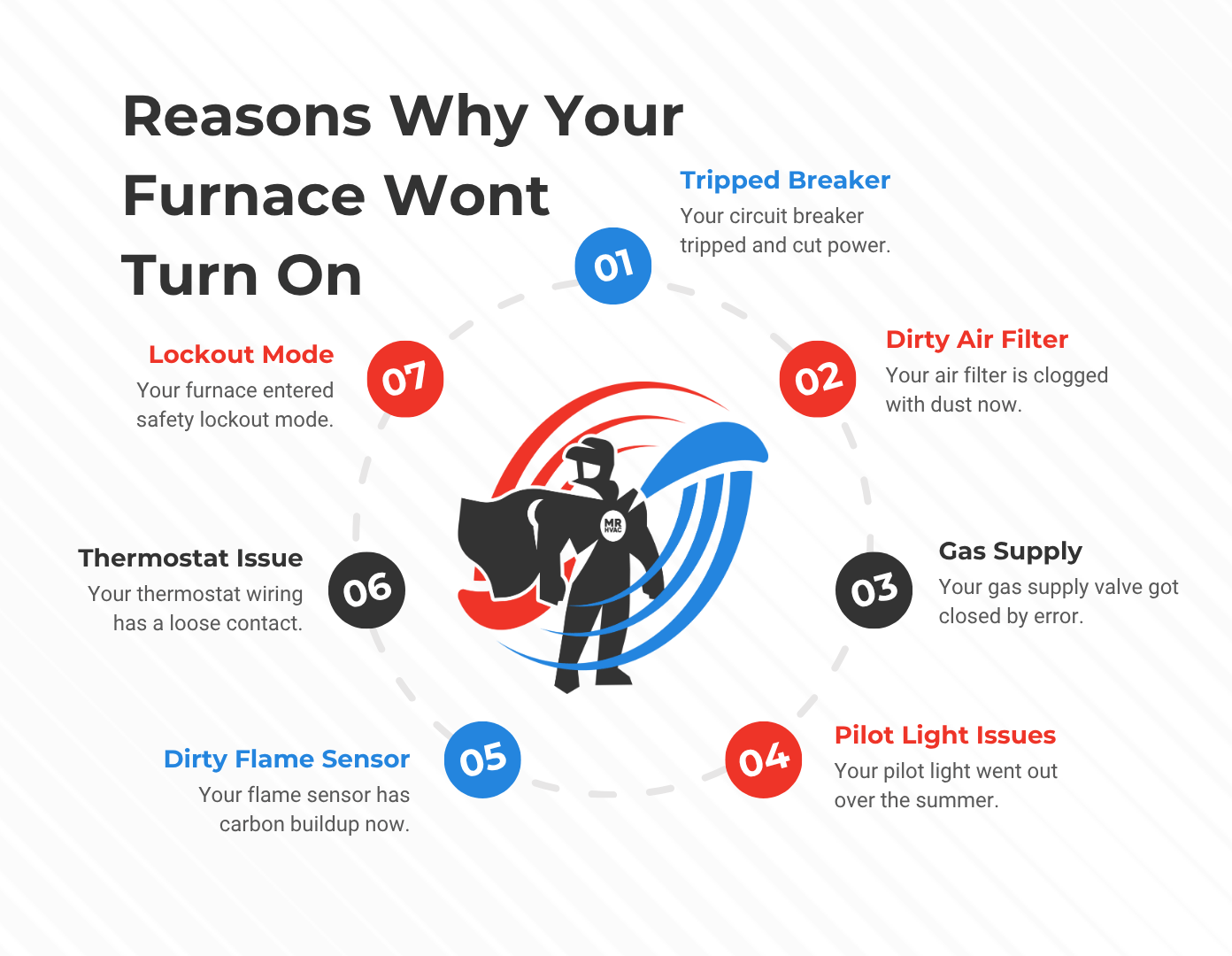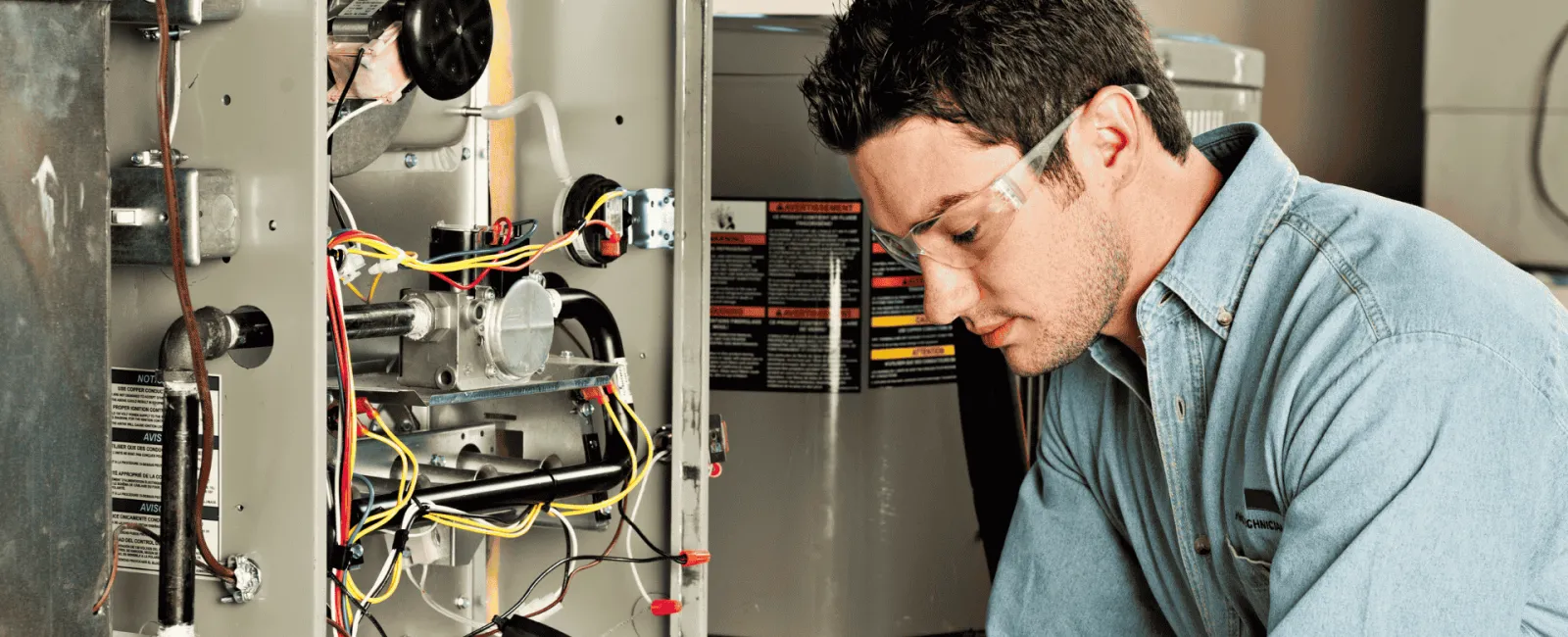If your furnace won't turn on, you're not alone. It's one of the most common HVAC issues homeowners face, especially in late October and early November when heating systems fire up for the first time in months. The good news? Many furnace problems have simple fixes you can try yourself before calling for furnace repair.

In this guide, we'll walk you through the seven most common reasons why your furnace is not turning on and show you exactly what to check. We'll be honest about what you can handle on your own and when it's time to call in a professional. Let's get your home warm again.
Why Your Furnace Not Turning On Is More Common Than You Think
Here's the thing about furnaces in many parts of the country: they sit unused for eight to nine months out of the year. While your air conditioner gets a workout all summer long, your furnace is essentially dormant from spring through early fall. When you finally need it in late fall or winter, that long break can cause issues.
Dust settles on components, pilot lights go out, filters get forgotten, and small problems that wouldn't matter during regular use suddenly prevent your entire system from starting. It's completely normal, and in most cases, it's fixable without a major repair bill.
What to Check First: The Simple Stuff
Before we dive into the seven main reasons your furnace won't turn on, let's knock out the basics. You'd be surprised how often the solution is simpler than you think.
Is Your Thermostat Actually Calling for Heat?
This sounds almost too simple, but check your thermostat settings first. Make sure it's set to "heat" mode (not "cool" or "off") and that the temperature is set higher than your current room temperature. If you have a battery-powered thermostat, try replacing the batteries. Sometimes, a thermostat with dying batteries may not communicate properly with your furnace, even if the display remains lit.
Check the Power Switch
Most furnaces have a power switch located on or near the unit itself. It resembles a regular light switch, typically located in a metal box on the wall near your furnace. Make sure it's in the "on" position. It's surprisingly easy for this switch to get bumped off, especially if you store things near your furnace or if kids play in the basement.
7 Common Reasons Your Furnace Is Not Turning On
1. Tripped Circuit Breaker
The most common reason for a furnace not turning on? A tripped circuit breaker. Head to your electrical panel and look for the breaker labeled for your furnace or HVAC system. If it's in the middle position or flipped to "off," that's your culprit.
Flip it all the way off, then back on. If it trips again immediately, that signals a deeper electrical problem that needs professional attention. Don't keep resetting a breaker that repeatedly trips; this is a safety issue that requires professional furnace repair.
When to call a pro: If the breaker trips more than once or if you're uncomfortable working with your electrical panel.
2. Dirty or Clogged Air Filter
A dirty air filter is one of the sneakiest causes of furnace problems. When your filter gets clogged with dust, pet hair, and debris, it restricts airflow to your system. Your furnace's safety features detect this restricted airflow and shut the system down to prevent overheating.
Locate your air filter (typically situated in the return air duct or a slot on the furnace itself) and remove it. Hold it up to a light. If you can't see light passing through, it's time for a replacement. Even if it doesn't look terrible, if you can't remember the last time you changed it, go ahead and put in a fresh one.
This is especially common after a long cooling season. Your AC has been running for months, and that filter has been catching all the dust, pollen, and particles your system pulls through. By the time heating season arrives, it's often completely blocked.
Quick fix: Replace your filter with one that matches the size printed on the frame of the old filter. Most residential furnaces use 1-inch filters that should be changed every 1 to 3 months.
3. Gas Supply Issues
If you have a gas furnace (which most homes in the U.S. do), check that your gas supply valve is open. This valve is typically located on the gas line that leads to your furnace. The handle should be parallel to the gas pipe, which means it's open. If it's perpendicular (forming a 90-degree angle with the pipe), it's closed.
Important safety warning: If you smell gas anywhere in your home, don't try to turn anything on or off. Don't flip switches, don't light matches, and don't attempt to relight your pilot light. Get everyone out of the house immediately and call your gas company from a safe location outside. Gas leaks are serious and require immediate professional attention.
If the valve is closed and you don't smell gas, you can open it yourself. Turn the handle so it's parallel with the pipe. Then try your furnace again.
4. Pilot Light or Ignition System Problems
Older furnaces use a standing pilot light, a small flame that burns continuously and ignites your furnace when it needs to run. If you have an older system and the pilot light is out, your furnace won't turn on.
Look through the small window or access panel on your furnace. Do you see a small blue flame? If not, your pilot light is out. Most furnaces have instructions printed on the unit for safely relighting the pilot. Follow those instructions carefully.
Modern furnaces use electronic ignition systems instead of pilot lights. These systems have igniters that create a spark or hot surface to light the gas when your furnace calls for heat. If you hear your furnace trying to start but it clicks without igniting, the ignition system might be failing. This typically requires professional diagnosis and repair.
When to call a pro: If your pilot light won't stay lit after relighting or if you're not comfortable working with gas appliances, contact a technician for furnace repair service.
5. Dirty Flame Sensor
Here's a problem that catches many homeowners off guard: your furnace might actually be trying to turn on, but it shuts off after just a few seconds. If this is happening, you probably have a dirty flame sensor.
The flame sensor is a safety device that confirms your furnace's burners are actually lit before allowing gas to continue flowing. Over time, this sensor gets coated with carbon buildup and residue. When it can't detect the flame properly, it shuts your system down as a safety precaution.
While it's possible to clean a flame sensor yourself (it's usually a thin metal rod near the burner assembly that can be gently wiped with fine sandpaper), this requires accessing the inside of your furnace. Many homeowners prefer to have a professional handle this during routine maintenance.
When to call a pro: If you're not comfortable opening your furnace cabinet or if the sensor cleaning doesn't solve the problem.
6. Thermostat Wiring or Communication Issues
Sometimes your furnace won't turn on because it's not receiving the signal from your thermostat. This can occur due to loose wiring, a malfunctioning thermostat, or a faulty connection at the furnace control board.
If you've already replaced the thermostat batteries and confirmed the settings are correct, but your system still won't respond, the issue might be in the wiring. You might notice your thermostat display is blank or dim, or it might be lit up, but your furnace never responds when you adjust the temperature.
This is one of those problems that looks straightforward but can actually be tricky to diagnose. While a homeowner can check for obviously loose wires, diagnosing communication problems between your thermostat and furnace typically requires specialized knowledge and testing equipment.
When to call a pro: Thermostat and control board issues are best left to licensed HVAC technicians who can properly diagnose and repair electrical components.
7. Furnace Lockout Mode (Safety Shutoff)
Modern furnaces have built-in safety systems that put the unit into "lockout mode" when they detect a problem. This is actually a good thing; it prevents potentially hazardous situations, such as gas buildup or overheating. However, it also means your furnace won't turn on until the issue is resolved and the system is reset.
Your furnace might be in lockout mode if you notice a flashing light on the control board. Different furnace brands use different flash patterns to indicate specific error codes. Check your owner's manual or look for a legend printed inside the furnace cabinet door to decode the meaning of those flashes.
Common causes of lockout mode include repeated ignition failures, flame sensor issues, pressure switch problems, or airflow restrictions. Sometimes you can reset the lockout by turning off power to the furnace for 30 seconds, then turning it back on. However, if the underlying problem isn't fixed, the furnace will revert to lockout.
When to call a pro: If your furnace repeatedly enters lockout mode or if you're unsure how to interpret error codes and troubleshoot the control system, it's time to call a professional for furnace repair.
Other Issues That Can Prevent Your Furnace From Starting
Beyond the seven main culprits, a few other problems can cause your furnace not to turn on:
- Condensate drain clog: High-efficiency furnaces produce condensation that drains away through a PVC pipe. If this drain clogs, a safety switch will prevent your furnace from running.
- Limit switch failure: This safety component prevents your furnace from overheating. If it's faulty, it might shut down your system even when temperatures are normal.
- Blower motor problems: If your blower motor has failed, your furnace might light but won't circulate warm air through your home.
- Blocked or closed vents: Too many closed vents in your home can create pressure imbalances that trigger safety switches.
Furnace Troubleshooting: What You Can Do vs. When to Call MR. HVAC
We believe in being honest with our customers. There are some furnace problems that you can handle yourself, and others that require professional expertise, specialized tools, and safety training.
Safe DIY Checks for Homeowners:
- Checking and adjusting thermostat settings
- Replacing air filters
- Resetting tripped circuit breakers
- Checking that the power switch is on
- Verifying the gas valve is open (if there's no gas smell)
- Looking for obvious blockages or closed vents
Preventing Future Furnace Problems
The best time to deal with a furnace that won't turn on is before it happens. Here's how to keep your system running reliably:
- Schedule annual maintenance: Have your furnace inspected and tuned up before heating season starts (ideally in early fall).
- Change filters regularly: Set a reminder to check your filter monthly and replace it every 1-3 months depending on conditions.
- Test your system early: Don't wait until the first really cold night. Test your furnace in October while it's still relatively mild outside.
- Keep the area around your furnace clear: Don't store items against or on top of your furnace.
- Pay attention to strange sounds or smells: Catching small problems early prevents big breakdowns later.
When You Need Fast, Reliable Furnace Repair
At MR. HVAC, we understand that furnace problems never happen at convenient times. That's why we offer 24/7 emergency service to homeowners throughout our service area. We're a family-owned business that treats every customer like family, which means honest assessments, upfront pricing, and no pressure to buy services you don't need.
If you've tried the troubleshooting steps in this guide and your furnace still won't turn on, we're here to help. We'll accurately diagnose the problem, clearly explain your options, and provide the most effective solution to restore your comfort.
What to Do Right Now If Your Furnace Won't Turn On
Here's your action plan:
- Check your thermostat settings and batteries
- Verify the furnace power switch is on
- Look at your circuit breaker panel
- Replace your air filter if it's dirty
- Confirm your gas valve is open (if you don't smell gas)
If these simple checks don't resolve the issue, or if you notice any unusual odors, strange noises, or recurring problems, it's time to call in the professionals. Don't try to force a furnace to work if it's refusing to start; there's usually a good safety reason for the shutdown.
Frequently Asked Questions
How do I manually restart my furnace?
To manually restart your furnace, locate the power switch near the unit and turn it off. Wait 30 seconds, then turn it back on. If you have an older furnace with a pilot light, follow the relighting instructions printed on your unit. For furnaces in lockout mode, turning off the power at the circuit breaker, waiting 30 seconds, and restoring power can reset the system. However, if the underlying problem isn't fixed, the furnace may shut down again.
Why won't my furnace turn on even though the thermostat is set to heat?
If your thermostat is set correctly but your furnace won't turn on, the problem could be a tripped circuit breaker, a dirty air filter restricting airflow, a closed gas valve, dead thermostat batteries, or a communication issue between the thermostat and furnace. Start with the simple checks first—verify power, replace the filter, and check the gas supply before calling for service.
What does it mean if my furnace clicks but won't start?
A clicking sound without ignition usually indicates a problem with the ignition system. The clicking is the sound of the igniter trying to light the gas, but something is preventing successful ignition. This could be a faulty igniter, a dirty flame sensor, low gas pressure, or a problem with the gas valve. This type of issue typically requires professional furnace repair.
Can a dirty filter really prevent my furnace from turning on?
Absolutely. A severely clogged filter restricts airflow so much that your furnace's safety systems will shut it down to prevent overheating. This is one of the most common causes of furnace problems, and it's also one of the easiest to prevent. Regular filter changes (every 1-3 months) can prevent this issue entirely.
Should I smell gas when my furnace won't turn on?
No, you should never smell gas. If you smell gas anywhere in your home, this is an emergency. Do not attempt to troubleshoot your furnace; don't turn any switches on or off, and refrain from lighting anything. Get everyone out of the house immediately and call your gas company from a safe location outside. Once they've ensured your home is safe, contact us for emergency furnace repair.
Get Your Heat Back On Today
A furnace that won't turn on is stressful, uncomfortable, and often seems to happen at the worst possible time. The good news is that many common causes have simple solutions you can try yourself. For everything else, MR. HVAC is here to provide fast, reliable, and honest service.
Schedule Your Furnace Repair Today or call us for immediate assistance. Your comfort is our priority.

